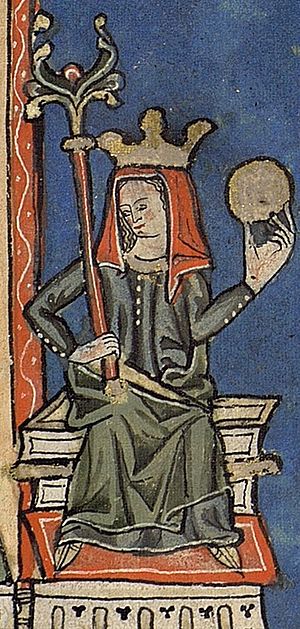Theresa, Countess of Portugal facts for kids
Quick facts for kids Teresa |
|
|---|---|
 |
|
| Countess of Portugal | |
| Reign | c. 1095/6 – 24 June 1128 |
| Successor | Afonso |
| Co-monarch | Henry (1095/6–1112) |
| Queen of Portugal (disputed) | |
| Reign | May 1117 – 11 November 1130 |
| Successor | Afonso I (from 1139) |
| Born | c. 1080 Disputed: Póvoa de Lanhoso, Portugal or Monastery of Montederramo, Galicia |
| Died | 11 November 1130 Monastery of Montederramo, Galicia |
| Burial | Braga Cathedral, Braga, Portugal |
| Spouse | Henry of Burgundy |
| Issue more... |
|
| House | Jiménez |
| Father | Alfonso VI of León and Castile |
| Mother | Jimena Muñoz |
Teresa (also spelled Theresa) was an important leader in the history of Portugal. She was born around 1080 and died on November 11, 1130. Teresa was the Countess of Portugal and, for a time, she claimed to be its independent Queen. She was the daughter of King Alfonso VI of León and Castile. Teresa played a big role in shaping the future of Portugal, especially in its journey to become a separate kingdom.
Contents
Early Life and Marriage
Teresa was the daughter of King Alfonso VI of León and Castile and Jimena Muñoz. In 1093, her father arranged for her to marry a French nobleman named Henry of Burgundy. Henry was a nephew of Queen Constance and came from a royal family in France.
Henry was helping King Alfonso VI fight against the Muslims in the region that would become Portugal. In 1096, Henry and his cousin Raymond made a secret agreement. They promised to help each other gain more land and power after King Alfonso died. However, King Alfonso found out about their plan. He decided to give Henry control over the lands between the Minho River and Santarém. This area was previously governed by Raymond. This made Henry and Raymond rivals instead of allies.
After King Alfonso died in 1109, Henry and Teresa continued to rule these lands. They governed the area from the Minho River south to the Mondego River.
Leading Portugal
Becoming a Ruler
When Henry died in 1112, Teresa took over the leadership of Portugal. She had to manage both military and political challenges. She focused on the southern parts of her lands, which had recently been taken back from the Moors.
Teresa was recognized for her success in defending the city of Coimbra. Because of her strength and leadership, Pope Paschal II called her "Queen" in 1116. In her own documents, she sometimes called herself "Daughter of Alphonso and elected by God." In 1117, a document clearly called her "Queen." This led some people to consider her the first monarch of Portugal.
Challenges and Changes
Teresa wanted to expand her power. In 1116, she fought against her half-sister, Queen Urraca of León and Castile. They fought again in 1120. Teresa wanted a larger share of the lands that belonged to her father's kingdom.
To gain more power, Teresa formed a close relationship with a powerful nobleman from Galicia, Fernando Pérez de Traba. In 1121, while fighting her sister Urraca, Teresa was surrounded and captured at Lanhoso. A peace agreement was made with the help of important church leaders. The agreement stated that Teresa could be free. However, she had to agree that the County of Portugal would remain under the control of the Kingdom of León. This meant she was still a ruler, but she owed loyalty to León.
The End of Her Reign
By 1128, many Portuguese nobles and church leaders were unhappy with Teresa's alliance with Galicia. They worried that this alliance would give too much power to the Galician church.
The Portuguese nobles and warlords rebelled against Teresa. Her son and heir, Afonso Henriques, led the rebellion. Afonso's troops defeated Teresa's army at the Battle of São Mamede near Guimarães. After this battle, Teresa was removed from power. She, along with Fernando Pérez de Traba and their children, went into exile in the Kingdom of Galicia. Teresa died soon after, in 1130. Her son, Afonso, became the new ruler. He would later lead Portugal to become a fully independent kingdom.
Family and Legacy
Teresa had several children with Henry, Count of Portugal:
- Urraca of Portugal (born around 1095)
- Sancha of Portugal (1097–1163)
- Teresa of Portugal (born around 1098)
- Henry of Portugal (1106–1110)
- Afonso Henriques (1109–1185), who became the first King of Portugal. He was named after his grandfather, King Alfonso VI.
She also had two daughters with Count Fernando Pérez de Traba:
- Teresa Fernández de Traba (died 1180)
- Sancha Fernández de Traba (died after March 1181)
Teresa's life was full of challenges and changes. She was a strong leader who fought for her lands and her people. Her efforts helped set the stage for Portugal to become an independent nation.
See also
 In Spanish: Teresa de León para niños
In Spanish: Teresa de León para niños

